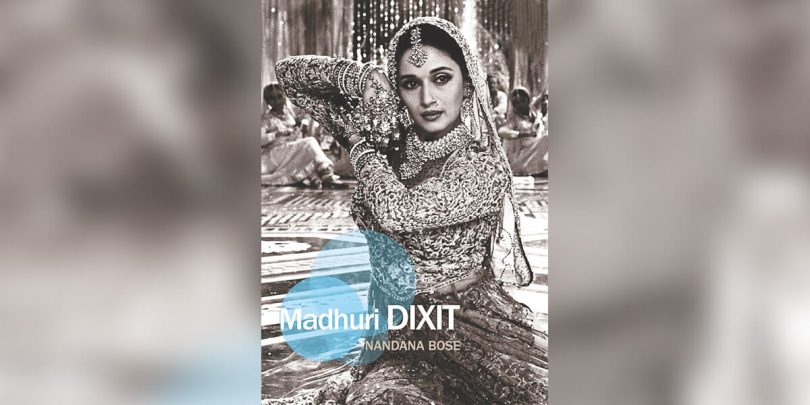The Indian film industry in Mumbai may produce the highest number of films in the world, but it remains indebted to one Madhuri Dixit who helped save ‘Bollywood’ in the late 1980s and the 1990s with her graceful existence. Nandana Bose’s book on the ‘eternally young’ Madhuri tells the readers why Bollywood remains grateful to the diva, how she changed the way actresses were perceived and what made her become the first ‘televisual star of her era’!
Published under the umbrella of the British Film Institute, this book is written mainly for the foreign fans of Madhuri, those in the West rather than the West of India (that’s us!). It gives the Bollywood outsiders a view of Madhuri Dixit’s career and why she matters to India despite her retirement. It may look like a biography but is in fact presented as a study that takes the readers down memory lane, at a time when Madhuri Dixit was making inroads as an actress.
It also traces the actress’s career that began in the mid-80s and discusses the ‘Madhuri effect’ that changed a lot of things using her star persona, her popularity, and her ability to stay relevant throughout her career. Divided into four chapters, the first one is aptly titled ‘India’s Dhak Dhak Girl – Rise to Stardom’ which discusses the early years of Madhuri’s career, followed by ‘A Zeitgeist Icon’ and ‘The Dancing Star’ that tackle her main years at the top. The last chapter ‘From Star to Celebrity’ discusses Madhuri’s career post-retirement as a leading lady, and how she managed to stay ‘in’ despite not acting in films regularly.
The author also reveals some of the lesser-known facts about Madhuri Dixit’s earlier career, and how she was ‘advertised’ before making it big in the industry that was famous for making and breaking careers. She first makes the readers comfortable in the 1980s, then introduces Madhuri in the latter half of the decade, and finally discusses her impact on Indian popular culture, and her continuing popularity even after turning fifty, five years back.
The best thing about this book is that it doesn’t limit itself to Madhuri Dixit, but for some die-hard fans, that can be a drawback. The author tells the readers how Madhuri changed from a young girl in a fantasy land into a whole nation’s fantasy, and how her evolution was in sync with that of the entire country. She was there when the VCR revolution was at its peak, she made her way to the top during the cinema revival of the 90s, and made a comeback when multiplexes became a norm in India.
Before Madhuri’s entry, Bollywood was on its way down but once she became ‘the’ Madhuri Dixit, she turned the spotlight on herself and stole the show with whatever opportunities she got. According to this book, Madhuri was always destined to make a name for herself, and that is why when the author discusses her career’s unusual trajectory, the readers are able to connect with the words as if it all happened yesterday instead of decades ago.
It is through this book that many readers would also realize that unlike the film actresses of her era, Madhuri was more of a hero, than a heroine because she changed trends, instead of following them. She was the first actress of her generation who led a scandal-free life (some of the rumors are addressed!), who chose to get married at the peak of her career, and who keeps herself busy by appearing on TV (as herself) unlike many actresses who have faded away after marriage. She may have acted in a handful of films in the last decade, but every time she has appeared on the big screen, she has performed as if she had never left!
The most important aspect of Madhuri’s career – dance – is given a whole chapter where the author talks about her inspirations, her performances, and her ability to outdo her co-stars (except one Prabhu Deva in Pukaar). How dance made her different from her contemporaries and how choreographer Saroj Khan featured in her success is what many would like to know, and what the author also presents with facts, figures, and films.
Enough of the pros, let’s discuss the cons. The book should have been more Madhuri-centric than India-centric, for the readers want to read why Madhuri chose different roles and how she felt during the making of some of her iconic films. Instead, they get a history lesson about the evolution of technology in India, and how advertisements changed the way things were marketed among other things.
And when you have a book on Madhuri without her colorful pictures, that’s unacceptable in my ‘book’. Although she doesn’t need color to look ‘perfect’ it would have added color to these pages. Yes, the readers get to read about her iconic films and characters but that’s not what they want in the first place. They wanted to read about their favorite star’s early life, how her colleagues saw her when she started, how her contemporaries felt about her when she was outgrowing them and how she managed to stay ahead of the others despite her advancing age. The 100-watt smile had something to do with her success, but there is no mention of that anywhere in the book.







